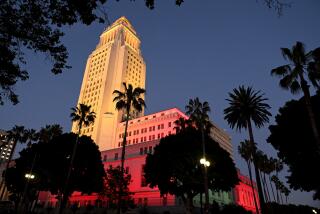Smoke-Free Redistricting
The citizen commission redrawing Los Angeles City Council districts launched a second round of public hearings this week to present its proposed boundary changes--and invited Angelenos to come “[throw] tomatoes at it.” Figurative tomatoes, we hope. Controversy is a given when remaking the city’s political map. Openness isn’t. For that, the commission deserves bouquets along with the inevitable brickbats.
Thanks to the 1999 charter reforms, Los Angeles joins the handful of governments that use an outside group to redraw electoral boundaries rather than leaving it to insider politics of the smoke-filled-room variety.
Whether at the national, state or local level, redistricting is triggered once a decade by the U.S. census and must reflect population swells and dips. New boundaries must also meet federal fairness requirements. But there is room for manipulating boundaries to include friendly voters and exclude troublesome ones. This can result in oddly shaped districts that serve politicians, not residents. Consider how the California Legislature wheeled and dealed and redrew to favor the incumbent party. The primary election was all that counted.
The L.A. City Council still has the power to engage in shenanigans because the commission’s role is advisory, but the process is now open enough to make such tinkering visible.
The new charter directed the commission to keep “communities of interest” intact as much as possible while meeting population and legal requirements. This was daunting, given the battles that even some Neighborhood Councils are fighting over boundaries. But the commission has largely succeeded, uniting communities like Van Nuys, which was divided among a record five council districts. The commission mapped a Los Angeles that reflects a shift in population--and clout--to the San Fernando Valley and to Latinos, while preserving the three districts dominated by black voters. This doesn’t mean that the process is divorced from politics. The 21-member panel was after all appointed by City Council members, the city attorney and Mayor James K. Hahn. The politics of incumbency play out in certain decisions.
To form a new district in the fast-growing east Valley, the commission would combine slower-growing Westside districts and literally move one to the Valley. The more likely to be moved of the two districts under consideration is the one represented by termed-out Councilwoman Ruth Galanter, who leaves office in 2003 and last year lost a bid for the council presidency. A related case is the old Valley district of resigned Councilman Joel Wachs. Whoever is elected March 5 to fill Wachs’ seat will want some sway over how that district is made. Even more important is what the voters who live in those districts have to say during the commission’s final public hearings, in the next several days.
Redistricting always causes screams of political pain. But the process this time has been better than what went before. The City Council needs to keep that public spirit in mind when it receives the commission’s final proposal March 1.
*
To Take Action: The commission will hold public hearings this Saturday, Monday and Wednesday. For times, locations and proposed district maps, go to the commission’s Web site, www.lacity.org/redistricting, or call (213) 473-4595. Mail comments to Los Angeles City Council Redistricting Commission, 250 E. 1st St., Suite 1005, Los Angeles, Calif. 90012.
More to Read
Sign up for Essential California
The most important California stories and recommendations in your inbox every morning.
You may occasionally receive promotional content from the Los Angeles Times.










